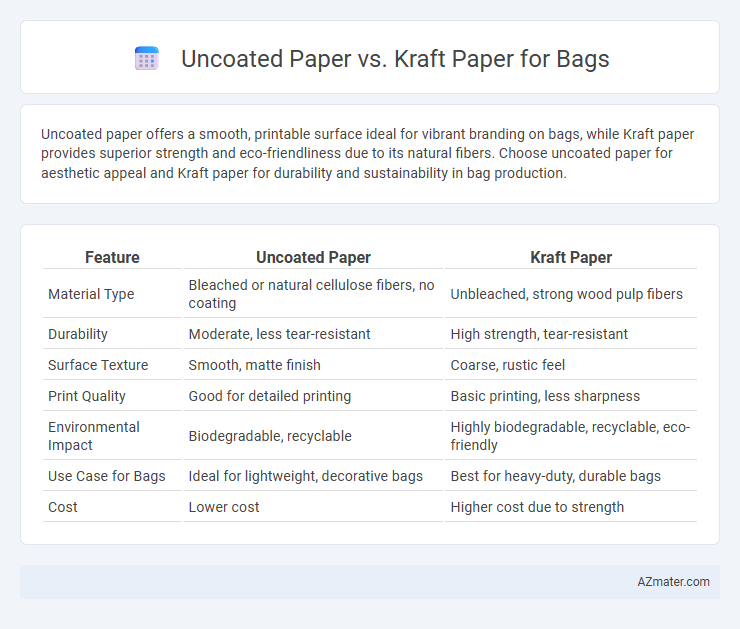Uncoated paper offers a smooth, printable surface ideal for vibrant branding on bags, while Kraft paper provides superior strength and eco-friendliness due to its natural fibers. Choose uncoated paper for aesthetic appeal and Kraft paper for durability and sustainability in bag production.
Table of Comparison
| Feature | Uncoated Paper | Kraft Paper |
|---|---|---|
| Material Type | Bleached or natural cellulose fibers, no coating | Unbleached, strong wood pulp fibers |
| Durability | Moderate, less tear-resistant | High strength, tear-resistant |
| Surface Texture | Smooth, matte finish | Coarse, rustic feel |
| Print Quality | Good for detailed printing | Basic printing, less sharpness |
| Environmental Impact | Biodegradable, recyclable | Highly biodegradable, recyclable, eco-friendly |
| Use Case for Bags | Ideal for lightweight, decorative bags | Best for heavy-duty, durable bags |
| Cost | Lower cost | Higher cost due to strength |
Introduction to Paper Bag Materials
Uncoated paper and Kraft paper are essential materials for manufacturing eco-friendly paper bags, each offering distinct properties that influence durability and appearance. Uncoated paper provides a smooth, printable surface ideal for high-quality graphics and branding, while Kraft paper is renowned for its strength, abrasion resistance, and natural brown color that appeals to sustainable packaging needs. Choosing between uncoated and Kraft paper depends on factors like bag size, weight capacity, and environmental impact priorities in packaging design.
What is Uncoated Paper?
Uncoated paper is a natural, untreated paper that lacks a glossy or coated surface, making it highly absorbent and ideal for printing with rich textures and vivid colors. It is commonly used for eco-friendly bags due to its biodegradable and recyclable properties, offering a sustainable alternative to plastic. Compared to kraft paper, uncoated paper provides smoother printing surfaces but may have less durability and strength for heavy-duty bag applications.
What is Kraft Paper?
Kraft paper is a strong, durable paper made from chemical pulp produced through the kraft process, known for its high tear resistance and natural brown color. Unlike uncoated paper, which lacks a protective coating and has a smoother finish, kraft paper is commonly used for bags requiring enhanced strength and eco-friendliness. Its versatility and recyclability make it a preferred choice for packaging applications focused on sustainability and durability.
Durability Comparison: Uncoated vs Kraft Paper
Kraft paper exhibits superior durability compared to uncoated paper for bags, offering enhanced tensile strength and resistance to tearing under heavy loads. The natural fiber composition and longer fiber length of kraft paper contribute to its robustness, making it ideal for carrying heavier items. Uncoated paper, while environmentally friendly and flexible, tends to have lower durability and may not withstand rough handling or moisture as effectively as kraft paper.
Environmental Impact and Sustainability
Uncoated paper and Kraft paper both offer eco-friendly options for bag manufacturing, but Kraft paper stands out due to its superior durability and recyclability, often produced from recycled wood pulp with minimal chemical processing. Uncoated paper, while biodegradable and recyclable, typically has a shorter lifespan and is less resistant to wear, which may increase waste generation. Choosing Kraft paper bags supports sustainability goals by reducing resource consumption and promoting circular economy practices in packaging.
Printability and Customization
Uncoated paper offers excellent printability with vibrant color reproduction and fine detail, making it ideal for high-quality bag designs requiring precise customization. Kraft paper, known for its natural texture and durability, provides limited print clarity but excels in eco-friendly, rustic packaging aesthetics. Choosing between the two depends on whether visual impact or sustainable branding is the priority for bag customization.
Cost Differences Between Uncoated and Kraft Paper
Uncoated paper generally costs less than kraft paper due to its simpler manufacturing process and lower durability requirements. Kraft paper, made from chemical pulp, offers higher strength and tear resistance, which increases production costs but enhances bag longevity. Businesses choosing between these materials must balance cost efficiency with performance needs, as kraft paper bags typically command a higher price point reflecting their superior durability.
Typical Applications in Bag Manufacturing
Uncoated paper is commonly used in retail and food packaging bags due to its smooth surface, printability, and eco-friendly qualities, making it ideal for shopping bags and bakery wraps. Kraft paper, known for its high durability and tear resistance, is typically employed in heavy-duty paper bags such as grocery sacks, industrial packaging, and lunch bags that require strength and moisture resistance. Both materials serve distinct functional needs in bag manufacturing, with uncoated paper favored for aesthetic appeal and Kraft paper preferred for robustness and longevity.
Consumer Perception and Aesthetics
Uncoated paper offers a smooth, natural finish that enhances the tactile experience and conveys an eco-friendly, premium image, appealing to consumers seeking sustainability and simplicity. Kraft paper features a rugged, earthy appearance with visible fibers, evoking authenticity and durability that resonate with eco-conscious buyers and brands emphasizing rustic charm. Both materials influence consumer perception through visual texture and color, where uncoated paper tends toward refined elegance while kraft paper suggests robustness and naturalness in packaging design.
Choosing the Right Paper for Your Bag Needs
Uncoated paper offers a smooth, natural finish ideal for high-quality printing and eco-friendly packaging, making it suitable for retail bags requiring vibrant branding. Kraft paper, known for its strength and durability, excels in heavy-duty or industrial bags where resilience and tear resistance are priorities. Selecting the right paper depends on the bag's intended use, with uncoated paper favored for aesthetics and kraft paper chosen for robustness and sustainability.

Infographic: Uncoated paper vs Kraft paper for Bag
 azmater.com
azmater.com